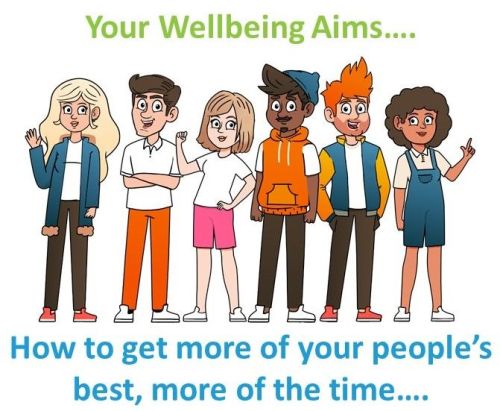Your Wellbeing Aims
Posted on

Wellbeing is a hot topic – rightly so. It’s the right thing to do, but that’s not enough to make it work. Because successfully delivering change isn’t easy in a busy organisation, especially in something as complex as wellbeing.
As leaders, we have to juggle the priorities. Wellbeing’s probably one of many things you’re being asked to deliver; and it’s frustrating, putting something that important on hold because there aren’t enough hours in the day. In almost half of organisations, operational demands take priority over wellbeing (CIPD Absence Management Survey). It’s a common dilemma.
But when your people are at their best, they’re brilliant. A successful wellbeing strategy supports the best of both worlds, improving performance without driving your people harder, and wellbeing without adversely impacting day-to-day operations.
So how do you strike that powerful balance? I believe that it starts with real clarity on what you want. To underpin everything that comes later – from choosing the activities to achieve those wants, to tracking their effectiveness and keeping them prioritised.
With any major change, it’s easy to assume that everyone wants the same thing. They rarely do. And ‘Because it’s the right thing to do’ is too ambiguous, and too easy to keep shelving for other, more pressing priorities.
When I train and mentor new change leaders, many struggle with the temptation to jump straight to solutions - to get it ‘fixed’ and move on, without fully understanding what they’re trying to achieve. It’s often what’s expected - quick wins are celebrated. Except they’re not always the win they seem - the risks are high, of treating only the surface symptoms, of delivering a solution which the organisation’s unable to maintain, and of damaging trust when it doesn’t work.
During my recent research, I’ve noticed that same straight-to-solution thinking showing up in many organisations - launching activities like Mental Health First Aid training or high-profile awareness weeks, without aligning them to an over all strategy or agreed wellbeing outcomes. It’s better than doing nothing, but with a little extra rigour, those gains can be so much greater.
Specifically, what do your stakeholders want to avoid and gain from improving wellbeing?
Maybe your Recruitment Manager wants to improve the organisation’s ability to attract the very best candidates, by showing how you care for and support your staff. Line managers might be fed up of having to correct the mistakes which get made when people are distracted, so they want to improve their team’s ability to stay focused. Your HR team might want to increase employee engagement, and to stop the disputes which get escalated to them because people let conflict build up when they’re feeling overloaded.
Have that conversation. Explore those wants, and how wellbeing affects each of them.
How might mental wellbeing impact each of the organisation’s KPIs?
Consider how many important decisions get shaped by the decision-maker’s state of mind. Because someone who’s feeling on top form probably makes much better decisions than the someone who’s dragged themselves into work after the 4th rubbish night’s sleep in a row.
How many mistakes get made because people are distracted by the run-in they’ve just had, or the fifteen different things they’ve got competing for their attention?
How many differences of opinion escalate into fallings-out or strained working relationships, because people don’t feel able to address them constructively when they come up?
We’re human. We make mistakes and get distracted. We rub each other up the wrong way sometimes. These things will always happen, but their frequency and severity are massively influenced by your people’s mental wellbeing.
It takes courage to lift the lid and look at what’s really going on under the surface. But that open discussion starts to build the awareness of those wider impacts of wellbeing, and its ability to shape everything that happens across the organisation. It starts to win it the priority that it really deserves.
And I know, it can be daunting, confronting all those potential issues when you haven’t yet got a solution. But this is the first step on the route to a real solution, not just a sticking plaster. To a successful wellbeing strategy that improves both wellbeing and performance. Trust the process….
To explore what comes next, join my webinar “4 Steps to Wellbeing Success”, where we’ll explore the Wellbeing Strategy Routemap. Drawn from nearly 20 years’ experience of leading transformation programmes and culture change, it’s packed with things I learned the hard way and wish I’d known sooner, to help you bypass the common pitfalls and frustrations, and maximise the returns on your wellbeing investment.
It's at 2pm on Thursday Jan 30th. Register to join (and receive the recording) at

Add a comment: